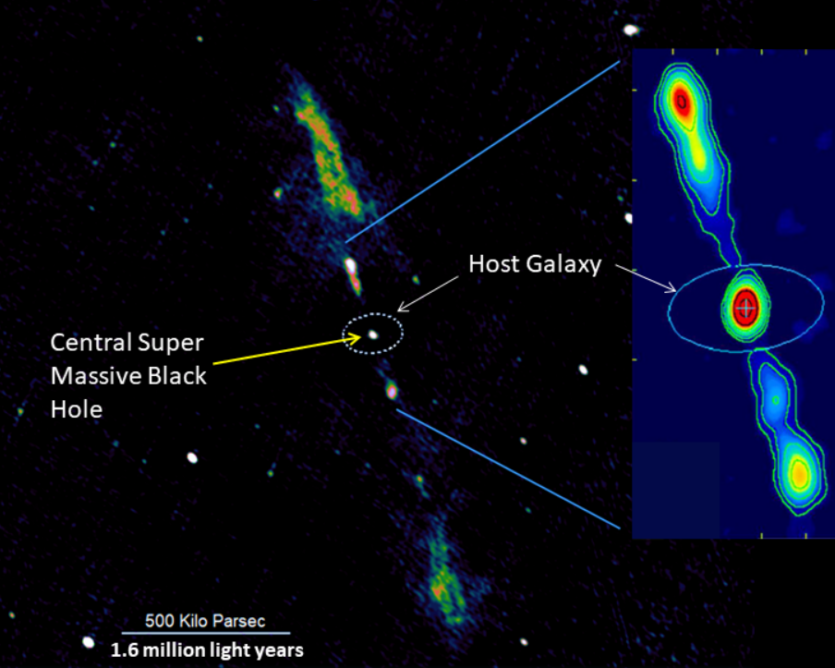
Astrophysicists have discovered a large-scale radiation from a supermassive black hole in the distant spiral galaxy 2MASX and are now wondering if the same thing could happen in the Milky Way.
Supermassive black hole in the 2MASX galaxy, J2345-0449 shows one of the most powerful emissions ever recorded. This galaxy contains much more dark matter than the Milky Way, with a size three times that of our own galaxy.
2MASX J2345-0449 is located 947 million light years from Earth. The length of the jets emitted by the supermassive black hole in this galaxy is 6 million light-years. According to scientists, its mass is 1.4 billion solar masses.
Scientists are wondering if this a black hole can radiate so massively, whether a similar thing could happen to the supermassive black hole Sagittarius A* in the center of the Milky Way and whether it would threaten life on Earth.
«This discovery is more than just a curiosity — it forces us to rethink how galaxies evolve and how supermassive black holes grow in them and shape their environment. If a spiral galaxy can not only survive but thrive in such extreme conditions, what does this mean for the future of galaxies like our own Milky Way? Could our galaxy one day experience similar high-energy phenomena that would have serious implications for the survival of the precious life in it?», — says team leader Joydeep Bagchi from CHRIST University in Bangalore, India, explaining the purpose of the study.
Astrophysicists discovered the radio burst using the «Hubble» telescope, the Giant Millimeter-wave Radio Telescope, and the ALMA Large Millimeter-wave Radio Telescope in the Atacama Desert. Before that, scientists believed that such a violent and powerful radiation coming out of the black hole in the galaxy 2MASX J2345-0449 should destroy the galactic structure itself, including the spiral arms.

However, the 2MASX galaxy J2345-0449 shows no changes and fully retains its own structure, including spiral arms, a bright cluster of stars and a star ring, despite being home to one of the most massive black holes ever discovered. This distant galaxy is surrounded by gas clouds, which in most galaxies would cool and condense, contributing to the star formation process. However, the supermassive black hole, which acts like a giant oven, heats the gas clouds with X-rays and prevents the formation of new stars.
Powerful black hole radiation includes cosmic and radioactive gamma rays, as well as X-rays, which pose a threat to any life that might have arisen in the 2MASX J2345-0449 galaxy.
Scientists emphasize that there are significant differences between the 2MASX J2345-0449 galaxy and our Milky Way galaxy. The Milky Way is three times smaller than the distant 2MASX J2345-0449. The black holes in the centers of both galaxies are also significantly different. The supermassive black hole in J2345-0449 is estimated to be in the range of 250 million to 1.4 billion solar masses, while Sagittarius A* has a mass of about 4.3 million suns.
The black hole at the center of 2MASX J2345-0449 is very active, as it absorbs large amounts of gas and dust that orbit around it, creating an accretion disk. The rest of the material not absorbed by the black hole rushes to the poles and at a speed close to the speed of light flies out into space in the form of radiation.
Sagittarius A* in the center of the Milky Way has no such power sources nearby. If we were to compare it to a human being, it would be like eating one grain of rice per million years.
However, the situation can change very quickly if this a black hole will be able to capture and gravitationally hold a large gas cloud or star, which it will begin to absorb. And although astrophysicists have seen many such events in other galaxies, they have never seen anything like this happen in Sagittarius A*.
If this black hole were to tear apart another large-scale cosmic object, the material from that object would form the same accretion disk around Sagittarius A*, which would then lead to powerful radiation. The threat from such radiation would depend on the direction of the rays, their strength, and the amount of energy they absorb.
If the radiation from Sagittarius A* were directed towards our solar system from a distance of 27 thousand light years from the Earth, it could destroy the atmospheres of planets, including the Earth, and destroy life on our planet. If the Earth were to be directly hit by such radiation, it would most likely lead to the mass extinction of all life.
Even if such radiation is not directed at an angle to the Earth, it could still have catastrophic consequences for the Milky Way. This would not be unprecedented in the Milky Way, which scientists believe was once devastated by huge radio jets. However, predicting if and when such jets might reappear from Sagittarius A* is not as easy as finding evidence of its historical activity.
During the study of J2345-0449, the team also found that this galaxy, which is three times larger than the Milky Way, contains ten times more dark matter than our galaxy. Unlike ordinary baryonic matter, which makes up stars, planets, and other cosmic objects, dark matter does not actually interact with light.
However, dark matter does interact with gravity, and this is important for J2345-0449. This distant, massive galaxy is spinning so fast that it requires a huge amount of dark matter to hold its structure together. This is the first time that astronomers have established a link between the dark matter content of a galaxy, the structure of that galaxy, and the activity of its central supermassive black hole. The team believes that further establishing this connection could open up a whole new frontier of scientific research.
https://itc.ua/en/news/a-high-school-student-accidentally-discovered-the-remains-of-the-largest-black-hole-twice-as-wide-as-the-milky-way/
The study was published in the journal Monthly Notices of the Royal Astronomical Society
Source: Space.com

Spelling error report
The following text will be sent to our editors: